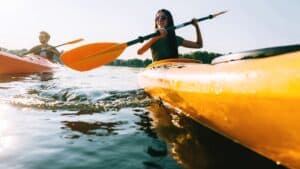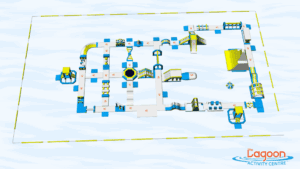Did you know that kayaking is one of the fastest-growing outdoor activities in the world? It’s no surprise considering the unique blend of adventure, tranquility, and physical fitness that kayaking offers. Whether you’re a water enthusiast looking to explore new horizons or a beginner seeking an exciting hobby, learning how to kayak can open up a world of possibilities.
In this beginner’s guide to kayaking, we’ll walk you through everything you need to know to get started. From essential safety tips and gear to mastering kayaking techniques and exploring diverse environments, we’ve got you covered. So strap on your life jacket and grab your paddle, because an unforgettable kayaking journey awaits.
Key Takeaways:
- Kayaking is a popular outdoor activity worldwide, offering adventure and physical fitness.
- This beginner’s guide will provide comprehensive information on kayak safety, gear, techniques, and environments.
- By following the guide, you’ll be well-prepared to embark on your kayaking adventure.
The Allure of Kayaking: A Beginner’s Perspective
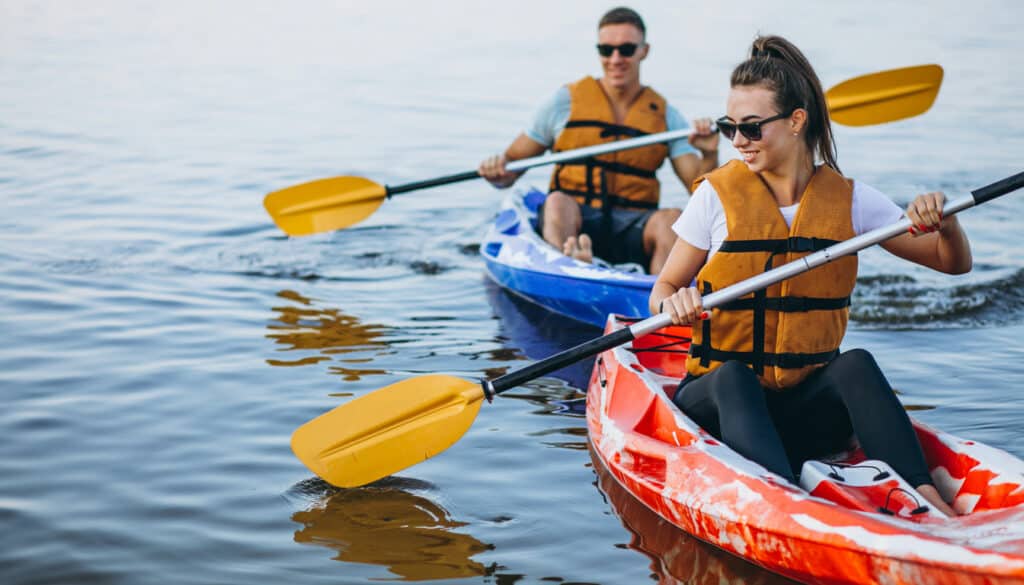
For beginners, kayaking holds a unique allure that combines the thrill of adventure with a deep connection to nature. It offers an opportunity to explore serene waterways, breathtaking landscapes, and vibrant wildlife. Whether paddling through tranquil lakes, meandering rivers, or along picturesque coastlines, kayaking presents an immersive experience that captivates the senses and provides lasting memories.
Choosing the Ideal Kayaking Destination
When planning a kayaking adventure, selecting the right destination is crucial. Consider factors such as water conditions, scenery, and accessibility to ensure a fulfilling experience. Whether it’s the calm waters of a peaceful lake, the gentle flow of a meandering river, or the exhilaration of paddling along the coast, each destination offers its own unique charm and challenges. Researching and choosing an ideal kayaking location will greatly enhance your journey.
The Intrinsic Advantages of Paddling
Beyond the captivating beauty of its surroundings, paddling comes with a range of intrinsic benefits. Engaging in this outdoor activity provides a holistic approach to physical fitness, fostering strength, endurance, and cardiovascular health. Moreover, kayaking serves as an effective stress-relieving exercise as you navigate tranquil waters and find solace in the rhythmic sound of your paddle strokes. Immerse yourself in the symphony of nature and savor the calmness it brings.
Along with the physical and mental advantages, kayaking offers the chance to explore new places, observe wildlife up close, and develop a deeper appreciation for the natural world. Whether it’s spotting birds soaring above, encountering fish gracefully gliding beneath the water’s surface, or marveling at the intricate flora bordering the banks, every moment on the kayak is an opportunity for discovery and connection.
Embarking on a kayaking adventure as a beginner opens up a world of possibilities. As you paddle through scenic landscapes, cherish the sense of freedom, tranquility, and exploration that kayaking provides.
Essential Kayaking Gear for the First-Timer
When it comes to kayaking, having the right gear is essential for a safe and enjoyable experience on the water. As a beginner, it’s important to invest in the right equipment that will enhance your comfort, safety, and overall performance. Here are some key items that every first-time kayaker should have:
Kayak Paddle: A high-quality paddle is crucial for efficient propulsion and control. Look for a paddle that is lightweight, durable, and appropriately sized for your height and paddling style.
Personal Flotation Device (PFD): Safety should always be a top priority, and wearing a properly fitted PFD is non-negotiable. This flotation device will keep you afloat in case of an accident and is a legal requirement in many places.
Proper Clothing: Dressing for kayaking requires consideration of the weather conditions. Opt for quick-drying, moisture-wicking clothing that provides protection from the sun and the water. Don’t forget a hat and sunglasses for added sun protection.
Bilge Pump: A bilge pump is a handy tool for removing water from the kayak’s hull. It helps keep the kayak dry and prevents it from becoming unstable due to excess water.
Maps or Compasses: Navigational aids like maps or compasses are essential for planning routes and ensuring you stay on the right track during your kayaking adventures.
Whistle or Signaling Device: A whistle or signaling device is a vital safety item that can be used to alert others if you are in distress or need assistance.
Helmet or Hat: Depending on the type of kayaking you plan to do, wearing a helmet or hat can provide added protection against head injuries and sun exposure.
Water and Snacks: Staying hydrated and fueled during your kayaking trips is crucial for maintaining energy and preventing dehydration. Pack plenty of water and nourishing snacks to keep you going.
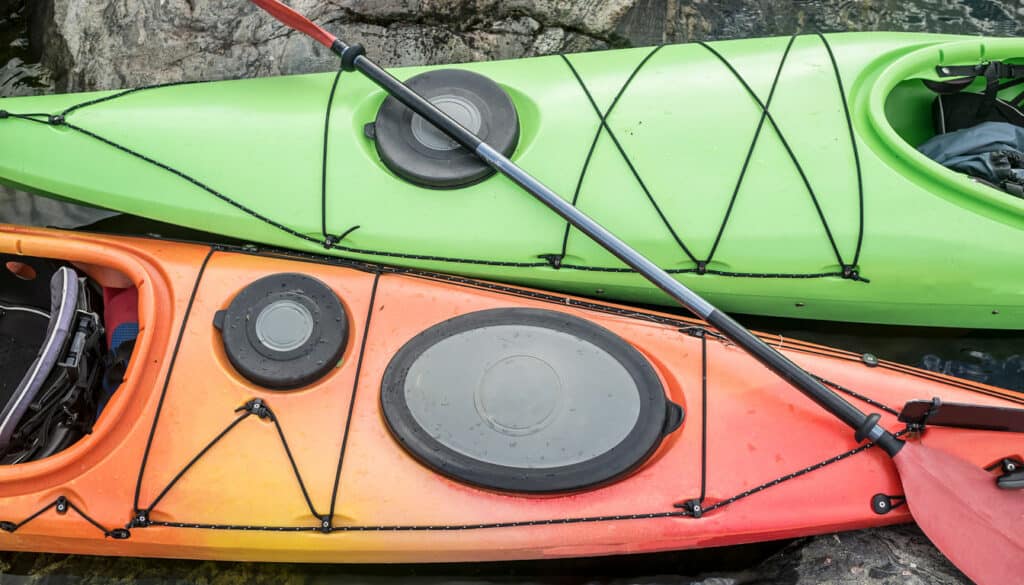
Having the right kayaking gear ensures that you are prepared for a safe and comfortable outing on the water. Investing in quality equipment will enhance your kayaking experience, allowing you to focus on the beauty of your surroundings and the thrill of paddling. So, gear up and get ready for an unforgettable adventure!
Understanding the Different Types of Kayaks
In the world of kayaking, there is a wide variety of kayaks available, each designed to suit different purposes and water conditions. Understanding the different types of kayaks is essential for beginners who are looking to embark on their kayaking journey. Let’s explore the characteristics and uses of these kayaks to help you make an informed decision when choosing the right one for your adventure.
Comparing Sit-on-top and Touring Kayaks
Two popular types of kayaks are sit-on-top kayaks and touring kayaks. Each has its own unique features and characteristics that cater to specific needs and preferences.
Sit-on-top kayaks are versatile and beginner-friendly. They are designed with an open cockpit, allowing paddlers to sit on top of the kayak rather than being enclosed inside. This design makes them easy to get in and out of, providing stability and a sense of freedom. Sit-on-top kayaks are great for recreational purposes, such as fishing or leisurely paddling in calm waters.
Touring kayaks, on the other hand, are designed for longer expeditions and paddling adventures. They feature a closed cockpit that offers protection from water splashes and provides a snug fit for the paddler. Touring kayaks are built for speed, efficiency, and stability, making them ideal for long-distance journeys and exploring various water conditions, including lakes, rivers, and coastal areas.
Specialised Kayaks: From Whitewater to Inflatables
In addition to sit-on-top and touring kayaks, there are specialized kayaks that cater to specific activities and water environments.
Whitewater kayaks are designed for navigating swift-moving rivers and rapids. They are agile, maneuverable, and built to withstand the challenging conditions of whitewater. These kayaks have a shorter length, planing hulls, and increased rocker for quick turns and effective control in turbulent waters.
Inflatable kayaks, as the name suggests, are lightweight and portable. They are made from durable materials that can withstand punctures and abrasions. Inflatable kayaks are perfect for those who have limited storage space or want the flexibility to transport their kayak easily. They are suitable for calm recreational paddling, fishing, and even mild whitewater adventures.
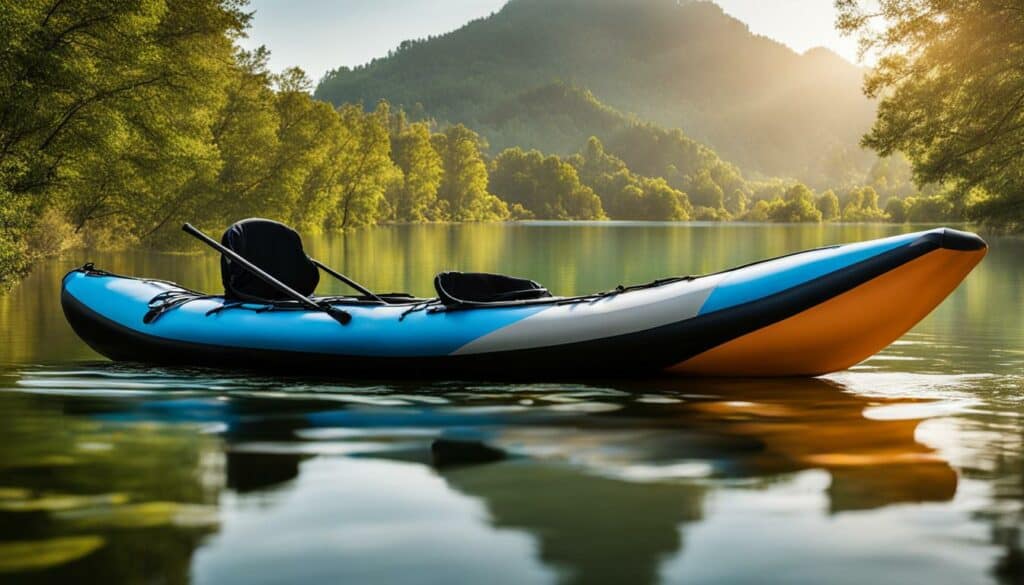
This image showcases the versatility and convenience of inflatable kayaks, highlighting their portability and ease of use.
By understanding the different types of kayaks available, beginners can make an informed choice based on their preferences, intended activities, and the water environments they plan to explore. Whether you opt for a sit-on-top kayak, touring kayak, whitewater kayak, or inflatable kayak, each type offers its own unique experience and opportunities for adventure.
Mastering Entry and Exit Techniques
Mastering the entry and exit techniques is essential for a safe and enjoyable kayaking experience. Whether you are launching from the shore or a dock, proper technique and balance are crucial to prevent capsizing and ensure a smooth entry and exit.
Here are some step-by-step instructions to help you master kayak entry and exit:
- Approach the kayak with caution, making sure it is stable and properly positioned.
- Hold the paddle securely, with one hand on the shaft and the other on the grip.
- Slowly lower yourself into the kayak, keeping your weight centered and balanced.
- Once inside the kayak, position your feet comfortably and securely on the footrests.
- To exit the kayak, reverse the entry process by placing your hands on the sides of the cockpit and pushing yourself up and out of the kayak.
- If you are exiting onto the shore, make sure to take small steps and maintain your balance as you get out.
Remember to use proper body mechanics and maintain a stable center of gravity throughout the entry and exit process. This will help you stay balanced and reduce the risk of accidents.
Using Paddle Floats and Other Tools
For beginners who are still perfecting their entry and exit techniques, using paddle floats and other tools can provide added stability and assistance. Paddle floats are inflatable devices that attach to your paddle and can be used as outriggers, making it easier to get in and out of the kayak.

By practicing and refining your entry and exit techniques, you will become more confident and efficient on the water. Take the time to learn and master these skills, and you’ll be well on your way to becoming a skilled kayaker!
How to Kayak: Core Techniques and Paddling Basics
This section will focus on core techniques and paddling basics for kayaking. It will provide instruction on developing an effective paddle stroke, including proper grip, posture, and rhythm. The section will also discuss controlling the kayak with paddling finesse, including techniques for turning, maneuvering, and maintaining stability. It will emphasize the importance of practicing these techniques to improve skills and confidence on the water.
Developing an Effective Paddle Stroke
One of the key aspects of kayaking is mastering the paddle stroke. It is crucial to develop an effective paddle stroke to propel your kayak efficiently and navigate different water conditions. Here are some tips to help you refine your paddle stroke:
- Proper Grip: Hold the paddle with a relaxed grip, ensuring that your hands are shoulder-width apart. Your knuckles should be facing upward, and your wrists should be straight.
- Posture: Maintain an upright and relaxed posture while paddling. Sit with your back straight and your legs comfortably positioned in the kayak.
- Rhythm: Establish a steady and rhythmic paddling rhythm. Engage your core muscles and use your torso to generate power during each stroke.
- Blade Angle: Place the paddle blade in the water at a slight angle, ensuring that the power face is facing backward. Use your lower hand to rotate the paddle shaft and pull it smoothly through the water.
- Exit and Recovery: As you complete each stroke, lift the paddle out of the water smoothly. Allow the blade to exit the water near your feet and recover it back to the starting position for the next stroke.
Remember, developing an effective paddle stroke takes practice. Start with slow and controlled strokes, focusing on technique rather than speed. Gradually increase your speed and confidence as you become more comfortable with the paddle stroke.
Controlling Your Kayak with Paddling Finesse
Paddling finesse is all about the subtle adjustments and techniques that allow you to control your kayak with precision and finesse. Here are some techniques to help you improve your paddling finesse:
- Turning: To turn your kayak, use a combination of forward and sweep strokes. The forward stroke on the side you want to turn to will initiate the turn, while the sweep stroke on the opposite side will help execute the turn smoothly.
- Maneuvering: When maneuvering your kayak in tight spaces or around obstacles, use draw and pry strokes. The draw stroke pulls your kayak sideways, while the pry stroke pushes your kayak away from the paddle.
- Maintaining Stability: Maintaining stability is essential while kayaking. To improve stability, practice bracing. When you feel your kayak tipping to one side, quickly extend your paddle on that side and press the blade into the water to provide support.
- Riding Waves: When paddling in the sea or on a river with waves, it’s crucial to understand how to ride them for maximum efficiency and control. Lean your kayak slightly into the wave as you approach it and use your paddle to maintain balance.
- Utilizing Edges: Learn to control your kayak by using the edges effectively. Leaning your body and shifting your weight to one side allows you to carve turns and maintain stability in different water conditions.
By practicing these paddling finesse techniques, you will gain better control and maneuverability of your kayak, enhancing your overall kayaking experience.
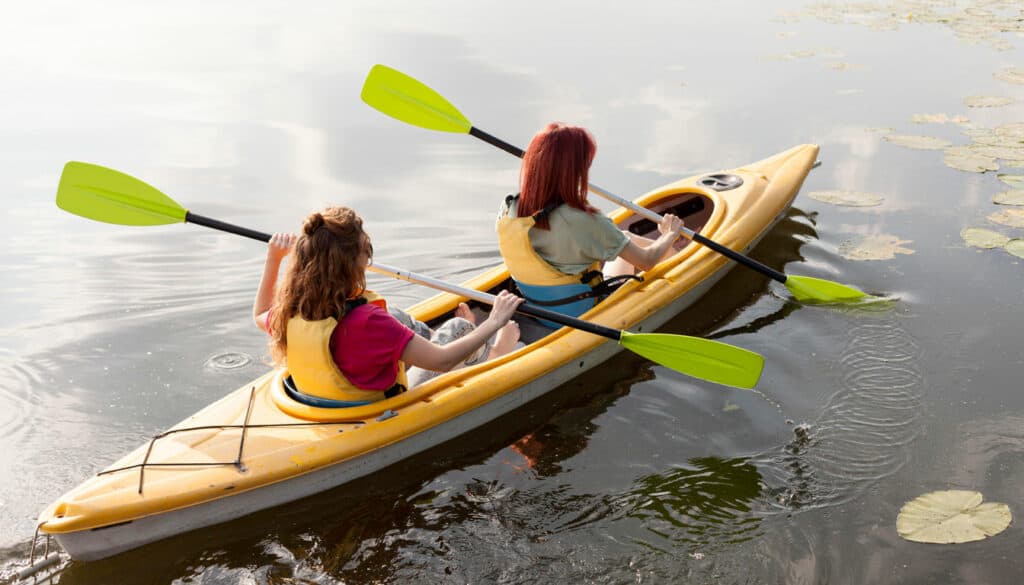
Navigating Kayaking Environments: Where Adventure Meets Safety
When it comes to kayaking, there’s a world of adventure waiting for you in various environments. From the rush of river kayaking to the serene beauty of lake kayaking and the captivating allure of coastal kayaking, each environment offers a unique experience for kayakers of all skill levels. However, it’s important to prioritize kayaking safety and have the necessary skills to navigate these different environments effectively.
Safely Exploring Rivers, Lakes, and Coastal Waters
Each kayaking environment comes with its own set of challenges and considerations. By understanding and respecting the specific characteristics of each environment, you can enjoy your kayaking adventures while ensuring your safety.
In river kayaking, it’s essential to:
- Understand the water flow and currents
- Wear appropriate safety gear, such as a helmet and a PFD
- Learn how to maneuver around obstacles and navigate rapids
- Stay aware of changing water conditions and potential hazards
In lake kayaking, keep in mind:
- The importance of checking weather conditions and understanding how wind can affect your paddling
- Being mindful of boat traffic and avoiding busy areas
- Knowing how to paddle efficiently and maintain stability in open water
- Being prepared for potential changes in weather conditions
When engaging in coastal kayaking, it’s crucial to:
- Be aware of tides, currents, and waves
- Have proper navigation equipment, including a compass and marine charts
- Understand marine traffic rules and give way to larger vessels
- Be prepared for changing weather conditions and potential rough seas
The Lagoon Activity Centre in Roscarbery: A perfect spot to learn kayaking
If you’re a beginner looking for a safe and picturesque location to learn kayaking, look no further than the Lagoon Activity Centre in Roscarbery. Situated on the coast of County Cork, Ireland, this idyllic spot offers calm and sheltered waters ideal for beginners.
The Lagoon Activity Centre provides a range of kayaking lessons and guided tours, allowing beginners to learn the ropes from experienced instructors. Whether you’re looking to explore the peaceful lagoon or venture out to nearby coastline, the Lagoon Activity Centre is the perfect starting point for your kayaking journey.
Remember, no matter where you choose to kayak, always prioritize your safety and follow the necessary precautions. By understanding the specific challenges and considerations of each kayaking environment, you can have a thrilling and secure adventure on the water.
Weather Wisdom: Preparing for the Unexpected
When it comes to kayaking, being prepared for the unpredictable weather conditions is crucial for a safe and enjoyable experience on the water. Checking the kayak weather conditions and understanding the forecast before embarking on your trip is essential. By doing so, you can make informed decisions and ensure your safety throughout the journey.
Here are some kayaking tips to help you navigate changing weather conditions:
- Check the weather forecast: Before heading out, always check the latest weather forecast for your kayaking location. Pay attention to wind speed, wave height, and potential storms. This information will help you determine whether it’s suitable and safe to go kayaking.
- Be aware of wind conditions: Wind can greatly impact your kayaking experience. Consider both the direction and strength of the wind. Kayaking against a strong headwind can be challenging and exhausting. It’s best to plan your route accordingly to avoid difficult paddling conditions.
- Watch out for waves: Waves can pose a danger to kayakers, especially if they are large or breaking. It’s important to assess wave height and frequency before entering the water. If conditions are rough, it’s advisable to stay closer to the shore or choose a different kayaking location with calmer waters.
- Be prepared for storms: Storms can develop quickly and dramatically change the weather conditions. Keep an eye on the sky and be aware of any signs of approaching storms, such as dark clouds or lightning. If you notice any, it’s crucial to head back to shore immediately and find shelter until the storm passes.
- Use your judgement: Ultimately, trust your instincts and use your judgement when it comes to kayaking in certain weather conditions. Safety should always be your top priority. If you’re unsure or uncomfortable with the weather conditions, it’s best to postpone your kayaking trip for another time.
By following these kayaking tips and staying informed about the weather, you can ensure a safe and enjoyable kayaking adventure. Remember, being prepared and making the right decisions based on weather conditions is essential for a successful outing.
Kayak Safety: Tips and Tricks for a Trouble-free Trip
In order to have a safe and enjoyable kayaking experience, it’s important to be prepared and knowledgeable about kayak safety. Here are some essential tips and tricks to ensure a trouble-free trip:
The Importance of Personal Floatation Devices
One of the most important aspects of kayak safety is wearing a personal floatation device (PFD) at all times while on the water. A PFD is designed to keep you afloat in the event of an accident or capsizing and can save your life. When choosing a PFD, make sure it is the right size and fits securely. It should be comfortable to wear and allow for freedom of movement.
Tip: A good PFD should be Coast Guard-approved and have a proper fit for your weight and size.
Communicating and Planning for Emergencies
Being prepared for emergencies is crucial when kayaking. Here are some tips to communicate and plan for emergencies:
- Carry a whistle or signaling device to attract attention in case of an emergency.
- Create a float plan and share it with someone you trust before you go kayaking. Include information about your route, estimated time of return, and emergency contacts.
- Learn basic first aid and CPR techniques to be prepared for accidents or injuries on the water.
Tip: It’s always a good idea to check weather conditions before your trip and be aware of any potential hazards such as strong currents or rough waters.
By following these kayak safety tips and tricks, you can have a worry-free and enjoyable kayaking experience. Remember to always prioritize safety and be prepared for any unexpected situations that may arise.
Conclusion
In conclusion, this beginner’s guide to kayaking has provided valuable insights into the world of kayaking. By following the safety guidelines and learning the proper techniques, beginners can ensure a safe and enjoyable kayaking experience. It is vital to prioritize safety by wearing personal floatation devices (PFDs) and being prepared for emergencies.
Throughout this guide, we have highlighted the significance of choosing the ideal kayaking destination and understanding different types of kayaks that suit individual preferences. Additionally, mastering entry and exit techniques and developing an effective paddle stroke are key skills to enhance kayaking proficiency.
It is essential to remember that kayaking offers adventure, connection with nature, and numerous physical and mental benefits. As beginners continue their kayaking journey, they should always prioritize safety and environmental responsibility, making sure to check weather conditions and plan accordingly. So grab your paddle, explore the vast waters, and embark on unforgettable kayaking adventures.
FAQ
How do I choose the right kayaking destination?
When choosing a kayaking destination, consider factors such as water conditions, scenery, and accessibility. Select a location that suits your skill level and offers a safe and enjoyable environment for kayaking.
What are the advantages of kayaking?
Kayaking offers a sense of adventure and connection with nature. It provides opportunities for physical fitness, stress relief, and exploration of new places and wildlife.
What essential gear do I need for kayaking?
Essential gear for kayaking includes a kayak paddle, a personal flotation device (PFD), and proper clothing for kayaking. Additionally, it is recommended to have a bilge pump, maps or compasses, a whistle or signaling device, and water and snacks for longer trips.
What are the different types of kayaks?
There are various types of kayaks, including sit-on-top kayaks, touring kayaks, whitewater kayaks, and inflatable kayaks. Each type has its own design and functionality, suited for different water conditions and activities.
How do I enter and exit a kayak safely?
To enter a kayak safely, step into the kayak with one leg at a time while maintaining your balance. When exiting, reverse the process by keeping your weight centered as you lift each leg out of the kayak.
What are the core techniques for kayaking?
Core techniques for kayaking include developing an effective paddle stroke with proper grip, posture, and rhythm. It is also important to learn how to control the kayak, including turning, maneuvering, and maintaining stability.
How can I navigate different kayaking environments?
To navigate different kayaking environments, such as rivers, lakes, or coastal waters, it is essential to understand the safety considerations and skills required for each. Seek information on the specific conditions and plan accordingly.
How should I prepare for changing weather conditions while kayaking?
Before kayaking, check weather forecasts and understand the current weather conditions. Be prepared to respond to changing conditions, such as wind, waves, or storms by making informed decisions and prioritizing your safety.
What are some kayak safety tips and tricks?
When kayaking, always wear a personal flotation device (PFD) and carry a whistle or signaling device. Plan for emergencies by creating a float plan and knowing how to respond to accidents or injuries on the water.


